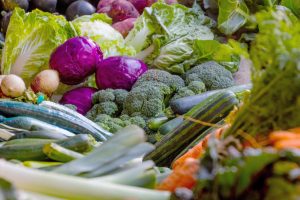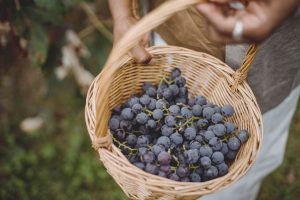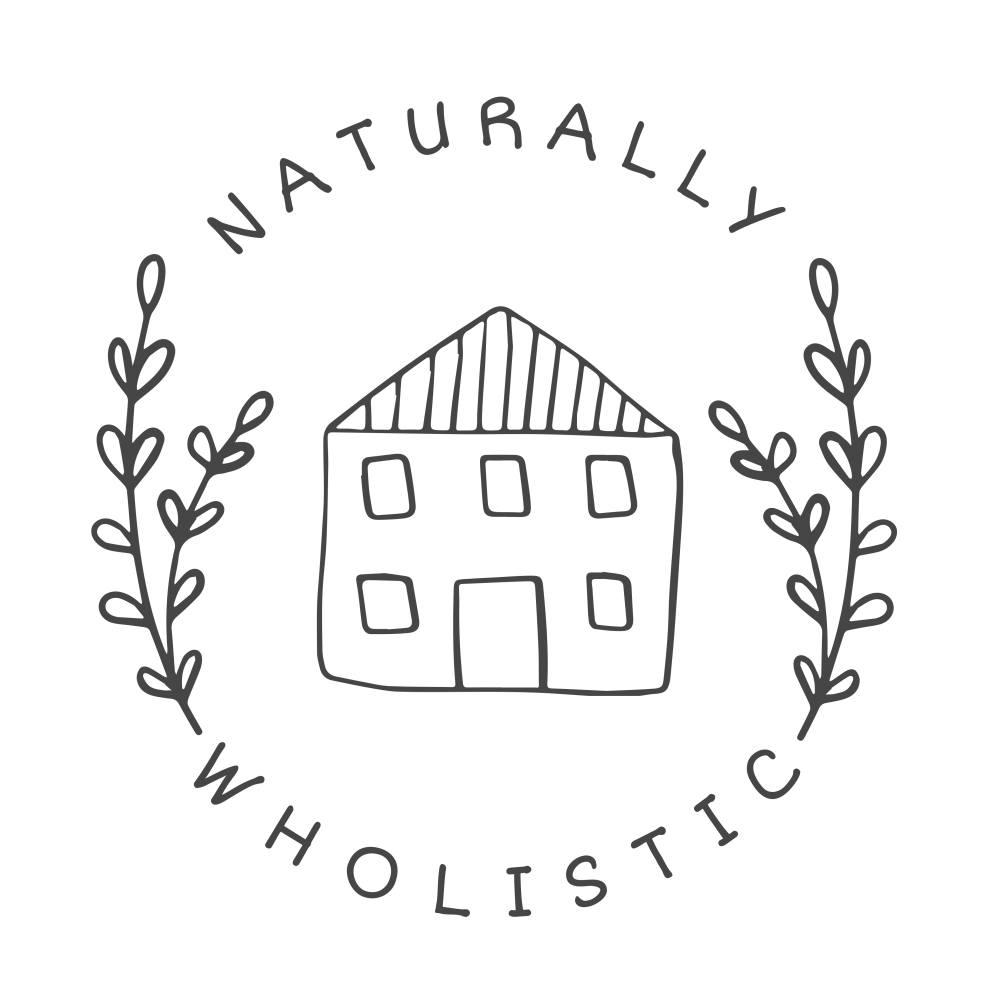We live in a society of information overload, at a time when everyone seems to have a strong opinion about what is the healthiest, most nourishing diet. I’ve shared before about how confusing it can be to figure out what we’re supposed to eat. But the truth is, it’s pretty simple. By using whole foods as our guiding staples, we can nourish our bodies and delight in yummy food.
.jpg) What are whole foods?
What are whole foods?
Simply stated, whole foods are real foods that are naturally grown or raised. They require minimal processing and often include just one ingredient. They’re the kinds of foods our ancestors ate, often coming straight from the farm. Whole foods do not contain un-pronouncable chemical additives or petroleum-based food colorings. They’re nutrient dense, they fill us up, and they fuel our bodies for optimal health.
As much as possible, I stick with whole foods that are organic, non-GMO, free range/pastured, and grass-fed. While they definitely cost more, it is an investment in my family’s health. If you have access to organic or non-GMO foods, using the EWG’s Dirty Dozen/Clean 15 lists is a helpful way to get started slowly introducing them into the grocery bill. Likewise, THIS LIST of online/delivery grocers can be a way to incorporate organics if stores aren’t available locally.
I think eating whole foods is such a freeing way to live. I do not count calories or fat grams, I do not weigh my food, and I do not worry about pairing particular foods together. I simply avoid processed foods as much as possible, though not expecting complete perfection from myself. I do keep a close eye on carbohydrates and sugars, but I have insulin resistance concerns that are not common to everyone. In general, I stick to an 80-20 policy. I aim to eat whole foods 80% of the time, and allow myself to indulge in less-healthy foods about 20% of the time. If you saw my recent Instagram post about Thanksgiving prep involving Twinkies (ha!), you’ll know this to be true!
.jpg) Why eat whole foods?
Why eat whole foods?
Most people who eat whole foods share a number of positive impacts, including brighter skin, weight loss, higher energy levels, stronger hair and nails, improved mental clarity, and more restful sleep. Likewise, eating whole foods naturally helps reduce exposure to chemicals, preservatives, hormones, and highly processed ingredients. Given all of the possible negative effects of ingesting those additives on a consistent basis (like chronic inflammation), whole foods are a fantastic way to improve overall wellness.
Likewise, whole foods can help prevent many lifestyle diseases and can help regulate cholesterol levels. Also, the higher fiber content in fruits, vegetables, and whole grains keeps our digestive systems regulated, which is a contributing factor in optimal gut health. As Hippocrates says, “Let thy food be thy medicine and thy medicine be thy food.”
What foods are whole foods?
The beauty of regularly consuming whole foods is that there are infinite possibilities to create a varied and delicious menu. There are so many options, especially when focusing on the foods that are included, instead of focusing on the foods that are not.
 VEGETABLES. Veggies are some of the most nutrient-dense foods we can eat, offering lots of antioxidants, phytonutrients, vitamins, minerals, and protection against lifestyle diseases. I love the advice that we should eat the rainbow, and veggies sure are a great way to do that.
VEGETABLES. Veggies are some of the most nutrient-dense foods we can eat, offering lots of antioxidants, phytonutrients, vitamins, minerals, and protection against lifestyle diseases. I love the advice that we should eat the rainbow, and veggies sure are a great way to do that.
- Leafy Greens & Cruciferous Veggies like kale, microgreens, spinach, mustard greens, collard greens, dandelion greens, cabbage, romaine & salad lettuces, swiss chard, arugula, bok choy, broccoli, cauliflower, brussels sprouts, rutabaga, turnips, watercress, and radishes
- Low-Glycemic Veggies like asparagus, peppers, artichokes, celery, eggplant, onions, green onions, mushrooms, zucchini, green beans, tomatoes, and alfalfa sprouts
- Starchy Veggies like carrots, butternut squash, pumpkin, sweet potatoes, red potatoes, corn, parsnips, and beets
 FRUITS. Though I don’t personally eat many fruits because of the sugar content, they’re loaded with lots of good nutrients and fiber. Berries, in particular, are an excellent lower-sugar option, and they’re exploding with antioxidants and phytonutrients and all the nourishing things. Apples, cherries, oranges, grapes, pineapple, kiwi, banana, apricots, pears, peaches, plums, grapefruit, prunes, watermelon, and cantaloupe are some other great examples. Also, avocados are a powerhouse “fruit” and they make awesome guacamole.
FRUITS. Though I don’t personally eat many fruits because of the sugar content, they’re loaded with lots of good nutrients and fiber. Berries, in particular, are an excellent lower-sugar option, and they’re exploding with antioxidants and phytonutrients and all the nourishing things. Apples, cherries, oranges, grapes, pineapple, kiwi, banana, apricots, pears, peaches, plums, grapefruit, prunes, watermelon, and cantaloupe are some other great examples. Also, avocados are a powerhouse “fruit” and they make awesome guacamole.
 PROTEINS. There’s no dispute we need protein for lots of bodily functions, but there is certainly argument over what makes a healthy protein.
PROTEINS. There’s no dispute we need protein for lots of bodily functions, but there is certainly argument over what makes a healthy protein.
- Organic, grass-fed/pasture-raised meat and organs, preferably sourced from your local farmer, but HERE are other sources
- Organic, pasture-raised eggs
- Wild game like venison, buffalo, rabbit, or elk
- Wild-caught fish
- Legumes (see below)
LEGUMES. Legumes offer lots of fiber to support regular digestion, as well as keep us full longer. They support healthy blood sugar and cholesterol levels, and they are full of protein. Legumes include lima beans, black beans, kidney beans, cannellini beans, navy beans, pinto beans, chickpeas, soybeans, lentils, peas, and peanuts.
 NUTS & SEEDS. Bursting with protein, fiber, antioxidants, and heart-healthy nutrients, nuts and seeds are so good to work into your regular diet. Nuts can always be on hand for a quick sugar-stabilizing snack, and seeds can be added into just about anything, but I especially love them on salads. I also like to grind seeds to add them into baked goods (I love my Oster Travel Blender for this purpose). Great nut choices are walnuts, almonds, pecans, cashews, pistachios, hazelnuts, macadamia, or brazil nuts. They’re healthiest when raw or minimally processed without lots of additives, but I do love light roasting and salting. My favorite seed choices are flax, pumpkin, sunflower, chia, and hemp, but there are plenty of others like sesame and pine nuts. It’s better to store in airtight containers to prevent rancidity, and seeds should be stored whole until it’s time to grind them, as they lose nutritional content quickly after grinding.
NUTS & SEEDS. Bursting with protein, fiber, antioxidants, and heart-healthy nutrients, nuts and seeds are so good to work into your regular diet. Nuts can always be on hand for a quick sugar-stabilizing snack, and seeds can be added into just about anything, but I especially love them on salads. I also like to grind seeds to add them into baked goods (I love my Oster Travel Blender for this purpose). Great nut choices are walnuts, almonds, pecans, cashews, pistachios, hazelnuts, macadamia, or brazil nuts. They’re healthiest when raw or minimally processed without lots of additives, but I do love light roasting and salting. My favorite seed choices are flax, pumpkin, sunflower, chia, and hemp, but there are plenty of others like sesame and pine nuts. It’s better to store in airtight containers to prevent rancidity, and seeds should be stored whole until it’s time to grind them, as they lose nutritional content quickly after grinding.
 HEALTHY FATS. There is confusion and disagreement over what makes a healthy fat or if we should even eat much fat at all. But given that our brains are 60% fat, please believe that we need wholesome fats for proper cognitive function (and lots of other bodily functions as well). Counterintuitive to the high-carbohydrate, low-fat diet that has permeated the government nutritional standards in America, I advocate that healthy fats are nutritional powerhouses necessary for our bodies. I like minimally processed, organic cold-pressed avocado oil, coconut oil, and olive oil, as well as ghee and grass-fed butter (Kerry Gold is my favorite). I also like raw (or at least organic, minimally processed) milk products like yogurt and cheese.
HEALTHY FATS. There is confusion and disagreement over what makes a healthy fat or if we should even eat much fat at all. But given that our brains are 60% fat, please believe that we need wholesome fats for proper cognitive function (and lots of other bodily functions as well). Counterintuitive to the high-carbohydrate, low-fat diet that has permeated the government nutritional standards in America, I advocate that healthy fats are nutritional powerhouses necessary for our bodies. I like minimally processed, organic cold-pressed avocado oil, coconut oil, and olive oil, as well as ghee and grass-fed butter (Kerry Gold is my favorite). I also like raw (or at least organic, minimally processed) milk products like yogurt and cheese.
 HEALTHY GRAINS. It’s a topic of hot debate, but eating healthy grains should definitely be incorporated into a whole foods repertoire. Though I don’t believe they should be the main part of a meal, they offer lots of nourishing vitamin, minerals, and antioxidants. My favorites are brown rice, wild rice, quinoa (though technically a seed, many people consider it a grain), whole oats, and einkorn berries. I don’t often use barley, amaranth, buckwheat, rye, spelt, or the other lesser-known grains, but they are awesome choices to consider. As for modern flour, whole wheat is always the way to go when baking, but it shouldn’t be a staple. I prefer and almost exclusively bake with einkorn flour because it doesn’t spike my blood sugar like modern hybridized wheat.
HEALTHY GRAINS. It’s a topic of hot debate, but eating healthy grains should definitely be incorporated into a whole foods repertoire. Though I don’t believe they should be the main part of a meal, they offer lots of nourishing vitamin, minerals, and antioxidants. My favorites are brown rice, wild rice, quinoa (though technically a seed, many people consider it a grain), whole oats, and einkorn berries. I don’t often use barley, amaranth, buckwheat, rye, spelt, or the other lesser-known grains, but they are awesome choices to consider. As for modern flour, whole wheat is always the way to go when baking, but it shouldn’t be a staple. I prefer and almost exclusively bake with einkorn flour because it doesn’t spike my blood sugar like modern hybridized wheat.
 FERMENTED FOODS. The fermentation process adds loads of nutrients to foods as well as tons of good gut bacteria. Fermented foods are vital to promote good gut health, which is necessary for so many bodily functions, but especially for our immune system to function optimally. A healthy and diverse microbiome wards off so many diseases. And fortunately, incorporating probiotic-rich fermented foods into your lifestyle is easy to do. Keep a variety of fermented foods on hand to grab a few bites with your meal (think sauerkraut, kimchi, yogurt), as well as drinks (like kombucha, water kefir, or milk kefir). You can ferment your own foods, or buy in most grocery stores. It’s important that your sources not be pasteurized. The heat required to pasteurize food kills off all the good stuff.
FERMENTED FOODS. The fermentation process adds loads of nutrients to foods as well as tons of good gut bacteria. Fermented foods are vital to promote good gut health, which is necessary for so many bodily functions, but especially for our immune system to function optimally. A healthy and diverse microbiome wards off so many diseases. And fortunately, incorporating probiotic-rich fermented foods into your lifestyle is easy to do. Keep a variety of fermented foods on hand to grab a few bites with your meal (think sauerkraut, kimchi, yogurt), as well as drinks (like kombucha, water kefir, or milk kefir). You can ferment your own foods, or buy in most grocery stores. It’s important that your sources not be pasteurized. The heat required to pasteurize food kills off all the good stuff.
Also, though bone broth is not a fermented food, it’s such a fantastic addition for gut health or gut health restoration, I’m including it here. I always keep some on hand, especially for when someone in the family feels the slightest hint of sickness. Grandma really was right about that chicken soup!
 HERBS & SPICES. I think fresh herbs & dried spices are the best way to make food burst with flavor, and the added bonus is they can offer lots of nutrients, too! My favorites (in no particular order) are garlic (powdered and fresh), cinnamon (so good for blood sugar support), sea salt, chili powder, cumin, onion (powdered and minced), parsley, thyme, oregano, rosemary, allspice, basil, nutmeg, black pepper, ground mustard seed, cilantro, crushed red pepper, ginger, turmeric, sage, and Trader Joe’s 21 Seasoning Salute. There are truly endless possibilities. Other options to consider are coconut aminos (to replace soy sauce), nutritional yeast, and apple cider vinegar.
HERBS & SPICES. I think fresh herbs & dried spices are the best way to make food burst with flavor, and the added bonus is they can offer lots of nutrients, too! My favorites (in no particular order) are garlic (powdered and fresh), cinnamon (so good for blood sugar support), sea salt, chili powder, cumin, onion (powdered and minced), parsley, thyme, oregano, rosemary, allspice, basil, nutmeg, black pepper, ground mustard seed, cilantro, crushed red pepper, ginger, turmeric, sage, and Trader Joe’s 21 Seasoning Salute. There are truly endless possibilities. Other options to consider are coconut aminos (to replace soy sauce), nutritional yeast, and apple cider vinegar.
WATER. I’ve written about how important drinking water is, so I won’t rehash here. But I will add that it’s important to consider our water source, as many are contaminated with all kinds chemicals and pesticides that are not healthy for our bodies. It’s not something to which we often give much thought, but having water tested for contaminants can be enlightening. Disturbing results can be easily mitigated with a water filtration system, with my absolute favorite being the Berkey.
What next?
Eating whole foods doesn’t have to be an all-or-nothing endeavor. As I stated above, I’m more of an 80-20 gal, which frees me from making my diet become an obsessive idol. My encouragement to you, though, is to pick one step that feels reasonable and doable. Perhaps that means working on making one meal of the day a whole foods meal, or perhaps it means committing to cooking one dinner from whole foods each week. Or maybe it means trying to replace packaged snacks with nuts or whole fruits or raw veggies with guacamole. Whatever you decide, remember that one small step can impact your health for the rest of your life.
![]()
 TIME TO START YOUR HEALING JOURNEY
TIME TO START YOUR HEALING JOURNEY
Let’s heal our health. Join me in the journey to create natural, wholistic, healing homes that offer safe havens where our families can connect, thrive, and find joy in wellness. When we fuel our bodies properly, practice the self-care we need, and experience connecting relationships, we can all resiliently thrive together and fulfill our God-given purposes.
SIGN UP to receive empowering email messages to help your family find healing through self care, wholistic wellness, and connected parenting.
.png)







